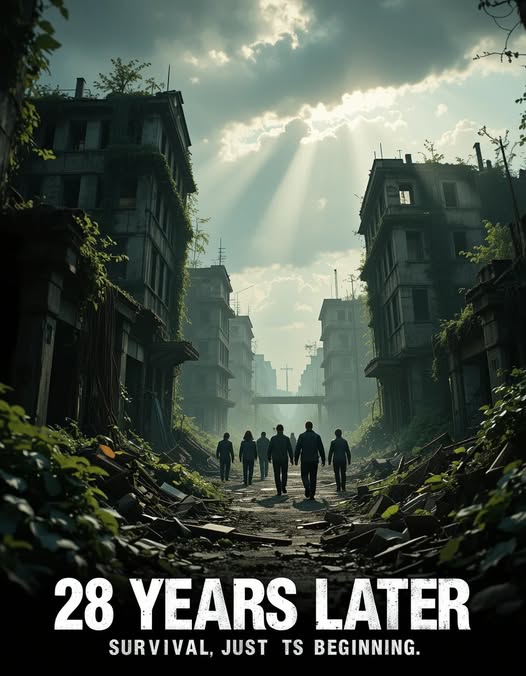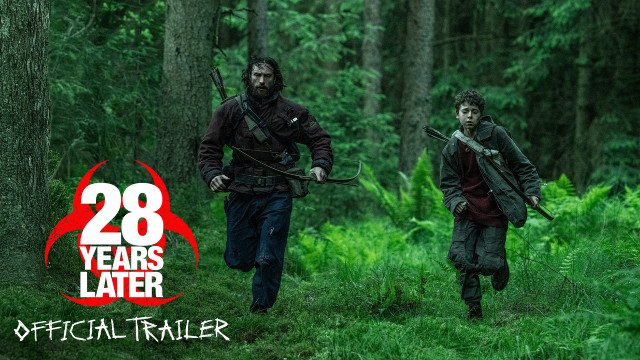28 Years Later (2025)

Unveiling the Epic Return of a Horror Legend – 28 YEARS LATER (2025): A New Dawn of Terror
When 28 Days Later burst onto screens in 2002, it redefined the zombie genre with its raw intensity, groundbreaking fast-moving infected, and hauntingly human story. Its sequel, 28 Weeks Later (2007), expanded the scope with visceral action and a broader look at societal collapse. Now, nearly two decades later, the saga continues with 28 Years Later (2025), a film that promises to push the boundaries of horror, science fiction, and human drama to new heights. Directed by Danny Boyle and penned by Alex Garland—the creative minds behind the original—this third installment is poised to be a cinematic milestone. In this comprehensive post, we’ll dive deep into every facet of 28 Years Later: from its production journey, cast, speculated plot, to its cultural significance and what fans can expect from this long-awaited chapter. Buckle up for a journey into a world ravaged by rage.
1. The Genesis of 28 Years Later: A Long-Awaited Revival
The 28 Days Later franchise has always been more than just a zombie series—it’s a chilling exploration of humanity’s fragility and resilience in the face of catastrophe. After 28 Weeks Later left audiences with a cliffhanger suggesting the global spread of the Rage Virus, fans clamored for a third film. However, for years, the project remained in limbo due to creative differences, scheduling conflicts, and the evolving landscape of horror cinema. In 2023, whispers of a revival grew louder, and by early 2024, Sony Pictures officially announced 28 Years Later, sending shockwaves through the fanbase.
The film marks a triumphant return for director Danny Boyle, whose kinetic style and emotional depth made the original a classic. Boyle, known for Trainspotting, Slumdog Millionaire, and 127 Hours, brings his signature visual flair and storytelling prowess to this new chapter. The screenplay is written by Alex Garland, the mastermind behind 28 Days Later, Ex Machina, and Annihilation. Garland’s ability to blend philosophical questions with visceral horror ensures that 28 Years Later will be both thought-provoking and terrifying. The duo’s reunion is a major draw, promising a return to the raw, groundbreaking spirit of the original while embracing modern cinematic techniques.
Produced by Sony’s Columbia Pictures, the film also involves key figures from the franchise’s past, including producers Andrew Macdonald and Peter Rice, who have been with the series since its inception. The budget, rumored to be significantly higher than its predecessors (estimated at $60-75 million), reflects the ambition to deliver a blockbuster-scale horror epic. Filming took place in 2024 across the UK, with locations ranging from desolate rural landscapes to crumbling urban ruins, capturing the eerie desolation of a world 28 years after the outbreak. 28 Years Later is set for release on June 20, 2025, positioning it as a summer tentpole that could redefine the zombie genre once again.

2. A Stellar Cast: New Faces and Returning Legends
One of the most exciting aspects of 28 Years Later is its ensemble cast, blending rising stars, acclaimed veterans, and potential cameos from the franchise’s past. While the filmmakers have kept character details under wraps to avoid spoilers, here’s what we know about the key players:
- Cillian Murphy as Jim (rumored): The star of 28 Days Later, Cillian Murphy, is confirmed to be involved, though his exact role remains mysterious. In the original, Jim was an ordinary bicycle courier who woke up to a world in chaos. Murphy, now an Oscar winner for Oppenheimer and a global icon, brings gravitas to the project. Speculation abounds that he could return as an older, battle-hardened Jim, a cameo, or even a new character tied to the original story.
- Jodie Comer as TBA: The Emmy-winning star of Killing Eve and The White Princess leads the new generation of survivors. Comer’s ability to portray complex, resilient characters suggests she’ll play a central figure—perhaps a leader or a scientist grappling with the Rage Virus’s legacy. Her casting has generated buzz for a fierce, emotional performance.
- Aaron Taylor-Johnson as TBA: Known for Kick-Ass, Bullet Train, and Kraven the Hunter, Taylor-Johnson brings action-hero charisma and dramatic depth. He’s likely to portray a rugged survivor or a military figure, with his physicality suited for the film’s intense sequences.
- Ralph Fiennes as TBA: The legendary actor, celebrated for Schindler’s List, The English Patient, and Harry Potter, adds prestige to the cast. Fiennes could play a scientist, a villainous leader, or a figure tied to the virus’s origins, given his knack for nuanced, commanding roles.
- Jack O’Connell as TBA: The Skins and Unbroken star is known for gritty, intense performances. O’Connell’s casting hints at a younger survivor, possibly a rebellious figure navigating the post-apocalyptic world.
Additional casting includes rising talents like Erin Kellyman (The Falcon and the Winter Soldier) and Scoot McNairy (Narcos: Mexico), suggesting a diverse group of characters from different walks of life. While no returning characters from 28 Weeks Later (like Rose Byrne’s Scarlet or Imogen Poots’ Tammy) have been confirmed, Boyle and Garland have hinted at subtle connections to the past, keeping fans guessing about potential surprises.

3. Speculated Plot: A World Transformed by Rage
While the official synopsis for 28 Years Later remains tightly guarded, clues from Boyle, Garland, and promotional materials offer a glimpse into its narrative. Set 28 years after the initial outbreak of the Rage Virus, the film explores a world forever altered by the pandemic. Unlike traditional zombie stories, the 28 Days Later series focuses on infected humans driven by uncontrollable rage, not undead corpses, making the stakes feel uniquely immediate and human.
Based on available information, here’s a speculated outline of the plot:
- A Fractured Society: The story picks up in a Britain that has partially rebuilt itself after decades of chaos. Isolated communities, fortified cities, and lawless wastelands coexist, with survivors divided by ideology—some seek to eradicate the infected, while others believe in coexistence or a cure. The Rage Virus, though contained in some areas, remains a latent threat, with outbreaks still occurring.
- A New Protagonist: Jodie Comer’s character is likely a central figure, possibly a scientist, doctor, or leader of a survivor enclave. Her mission could involve searching for a cure, protecting her community, or uncovering a dark secret about the virus’s origins. Her journey intersects with other survivors, including Aaron Taylor-Johnson’s character, who might be a pragmatic loner or a former soldier.
- The Return of the Infected: The infected remain a terrifying force, with Boyle teasing “evolved” versions that may be faster, smarter, or even capable of basic coordination. This evolution raises the stakes, forcing survivors to confront not just external threats but also moral questions about the infected’s humanity.
- Cillian Murphy’s Role: If Murphy reprises Jim, he could be a grizzled mentor figure, haunted by his past and leading a resistance against a new threat. Alternatively, he might appear in flashbacks, revealing what happened in the years after 28 Days Later, or as a symbolic figure tying the trilogy together.
- A Global Perspective: Unlike the UK-centric first two films, 28 Years Later may explore the virus’s global impact, with references to how other nations have fared. This broader scope could introduce new factions, such as a militarized group led by Ralph Fiennes’ character, whose motives—control, cure, or domination—remain ambiguous.
- Themes of Hope and Despair: True to the franchise, the film will balance horror with human drama, exploring themes of survival, sacrifice, and the cost of rebuilding. Expect emotional gut-punches, as characters face impossible choices in a world where trust is scarce.
The cliffhanger from 28 Weeks Later, where the virus appeared to spread to mainland Europe, suggests that 28 Years Later will address its global consequences. Garland has hinted at a story that’s “both a continuation and a reinvention,” blending the gritty realism of the original with a larger, more cinematic scope.
4. What to Expect: Key Highlights
28 Years Later is shaping up to be a landmark in horror cinema, combining the franchise’s signature intensity with ambitious new elements. Here are the standout aspects to anticipate:
- Visceral Horror: Boyle’s direction ensures the infected remain terrifying, with kinetic camerawork and claustrophobic tension. The evolved infected could introduce new scares, while practical effects and CGI blend to create gruesome, realistic carnage.
- Cinematic Scale: With a larger budget, the film promises sprawling set pieces—think abandoned cities overtaken by nature, fortified survivor camps, or chaotic battles against hordes of infected. Cinematographer Anthony Dod Mantle, a Boyle regular, will deliver haunting visuals that contrast beauty with decay.
- Emotional Depth: Garland’s script will likely focus on character-driven drama, exploring the psychological toll of living in a broken world. Relationships—familial, romantic, or adversarial—will anchor the story, making the horror hit harder.
- Social Commentary: Like its predecessors, 28 Years Later will reflect real-world anxieties. The Rage Virus has always been a metaphor for societal breakdown, and this film could tackle issues like pandemics, authoritarianism, or climate collapse, filtered through a post-apocalyptic lens.
- Soundtrack and Sound Design: The original film’s iconic score by John Murphy, particularly “In the House – In a Heartbeat,” became a cultural touchstone. Murphy is rumored to return, blending his atmospheric style with new compositions to amplify the film’s mood. Expect bone-rattling sound design to heighten the terror.
- Nods to the Franchise: Fans can look forward to easter eggs and callbacks, from subtle references to Jim’s bicycle courier days to echoes of 28 Weeks Later’s military experiments. Boyle has promised a film that honors its roots while forging a bold new path.
5. Cultural Significance and Legacy
The 28 Days Later franchise revolutionized horror by introducing fast-moving infected, influencing everything from World War Z to The Walking Dead. Its gritty realism, shot on early digital cameras, contrasted with the campy zombie films of the past, paving the way for a new era of genre storytelling. 28 Years Later arrives at a time when horror is thriving, with elevated films like Hereditary and Get Out proving the genre’s versatility.
This third film also reflects the franchise’s ability to evolve with the times. 28 Days Later captured post-9/11 fears of chaos and bioterrorism; 28 Weeks Later explored military overreach and refugee crises. In 2025, 28 Years Later is poised to resonate with audiences grappling with post-pandemic recovery, political division, and environmental concerns. Its focus on rebuilding society mirrors our own hopes and fears about the future.
Beyond its thematic weight, the film marks a milestone for Danny Boyle and Alex Garland, whose collaboration launched their careers into the stratosphere. It’s also a testament to Cillian Murphy’s enduring connection to the series, cementing his status as a genre icon. For fans, 28 Years Later is a chance to revisit a beloved world while introducing new generations to its terror and humanity.
6. The Road to Release: Expectations and Impact
As 28 Years Later approaches its June 2025 release, anticipation is sky-high. Early promotional materials—a teaser image of a ravaged London skyline, whispers of a trailer featuring Murphy’s voice—have ignited online buzz. The film’s summer slot, typically reserved for action blockbusters, signals Sony’s confidence in its broad appeal, blending horror with spectacle to draw diverse audiences.
Critically, the film faces high expectations. The original earned a 87% approval rating on Rotten Tomatoes, praised for its intensity and innovation, while 28 Weeks Later scored 71%, lauded for its action but critiqued for lacking the first’s intimacy. 28 Years Later must balance nostalgia with freshness, satisfying longtime fans while appealing to newcomers. Boyle and Garland’s track record suggests they’re up to the task, but the pressure is on to deliver a worthy capstone—or launchpad—for the trilogy.
Commercially, the film is poised for success. The global appetite for horror remains strong, with recent hits like A Quiet Place: Day One and Barbarian proving the genre’s box office power. 28 Years Later could gross upwards of $150-200 million worldwide, especially with its starry cast and franchise pedigree. Its streaming potential, likely on a platform like Netflix or Hulu post-theatrical run, ensures a long tail of viewership.
The film’s impact could extend beyond cinemas. A successful release might greenlight further sequels or spin-offs, potentially exploring other corners of the 28 Days Later universe. Merchandise, novelizations, or even a tie-in video game could capitalize on the hype, cementing the franchise’s place in pop culture.

7. Why 28 Years Later Matters
At its core, 28 Years Later is about humanity’s struggle to survive—and define itself—in the face of annihilation. The Rage Virus isn’t just a plot device; it’s a mirror reflecting our capacity for violence, fear, and hope. In a world still healing from real-life pandemics and societal upheaval, the film’s exploration of resilience feels urgent and universal.
For fans, it’s a chance to reconnect with a franchise that shaped modern horror. For newcomers, it’s an entry point to a world that’s equal parts terrifying and profound. Danny Boyle’s direction, Alex Garland’s writing, and a cast led by Cillian Murphy, Jodie Comer, and Aaron Taylor-Johnson promise a film that’s as emotionally gripping as it is adrenaline-pumping.
Conclusion
28 Years Later is more than a sequel—it’s a rebirth of a horror legend, a bold new chapter that honors its past while forging a daring future. With Danny Boyle and Alex Garland at the helm, a powerhouse cast, and a story that blends terror with humanity, the film is poised to be one of 2025’s most unforgettable cinematic experiences. Whether you’re a lifelong fan or a curious newcomer, this is a journey into darkness you won’t want to miss.
Mark your calendars for June 20, 2025, and prepare to face the rage once more. In a world where survival is never guaranteed, 28 Years Later reminds us what it means to fight, to hope, and to endure. Run. Hide. Survive.
Additional Info:
- Release Date: June 20, 2025
- Platforms: Theaters, with potential streaming release later
- Genre: Horror, Science Fiction, Thriller
- Estimated Runtime: Approximately 2 hours
Stay tuned to official channels for trailers and updates, and join the global fan community to count down to the apocalypse! 🧟♂️🎬